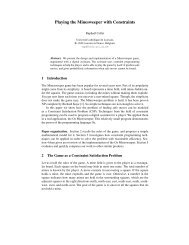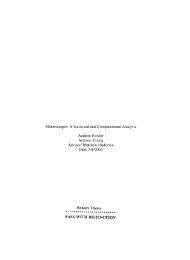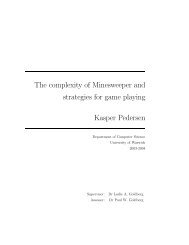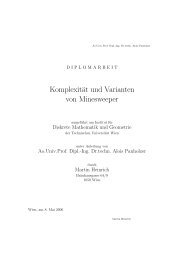An Interactive Constraint-Based Approach to Minesweeper
An Interactive Constraint-Based Approach to Minesweeper
An Interactive Constraint-Based Approach to Minesweeper
You also want an ePaper? Increase the reach of your titles
YUMPU automatically turns print PDFs into web optimized ePapers that Google loves.
<strong>An</strong> <strong>Interactive</strong> <strong>Constraint</strong>-<strong>Based</strong> <strong>Approach</strong> <strong>to</strong> <strong>Minesweeper</strong>Ken Bayer, Josh Snyder, and Berthe Y. Choueiry<strong>Constraint</strong> Systems Labora<strong>to</strong>ryDepartment of Computer Science and EngineeringUniversity of Nebraska-LincolnEmail: kbayer|jsnyde|choueiry@cse.unl.eduIntroductionWe present a Java applet that uses <strong>Constraint</strong> Processing(CP) <strong>to</strong> assist a human in playing the popular game<strong>Minesweeper</strong>. Our goal is <strong>to</strong> illustrate the power of CPtechniques <strong>to</strong> model and solve combina<strong>to</strong>rial problemsin a context accessible <strong>to</strong> the general public.<strong>Minesweeper</strong> is a video game that has been includedwith Microsoft Windows since 1989. In this game, theplayer is presented with a grid of squares. Each ofthese squares may conceal a mine. When the playerclicks on a square, it is revealed. If the square is amine, the game is over. If the square is not a mine,it is replaced by a number indicating how many of theadjacent squares are mines. The goal of the game is<strong>to</strong> reveal all squares that are not mines. These simplerules yield a complex problem: Kaye proved thatthe minesweeper-consistency problem is NP-complete(2000). The minesweeper-consistency problem is <strong>to</strong> determineif, given a board with some known squares,there exists a layout of mines in the unknown squaresthat is consistent with the numbers displayed.A few programs have been written <strong>to</strong> solve<strong>Minesweeper</strong>. One notable such program was developedby Collet (2004), and uses the Oz language <strong>to</strong>model and solve <strong>Minesweeper</strong> as a set of Boolean linearconstraints. In his implementation, Collet definesconstraints intensionally and generates dual variables<strong>to</strong> achieve higher-level consistency 1 . This model artificiallyand unnecessarily increases the number of variables(thus increasing the cost in terms of time andspace), and obscures the concept of ‘consistency level,’which is central <strong>to</strong> <strong>Constraint</strong> Processing.Like (Collet 2004), our program assists the player insolving <strong>Minesweeper</strong> puzzles by modeling them as <strong>Constraint</strong>Satisfaction Problems (CSPs). Although ourmodel is similar <strong>to</strong> that of Collet, it was developed independently.Also, our constraints are defined in extension,and, importantly, our implementation uses textbookpropagation-algorithms <strong>to</strong> determine the locationsCopyright c○ 2006, American Association for Artificial Intelligence(www.aaai.org). All rights reserved.1 Collet also generates all solutions (while exploiting symmetries)and infers the probability that a square is mined.We have not yet considered these extensions.of mines, thus better serving our pedagogical goals.We briefly discuss our motivations, then describe ourmodel, interface and implementation.Motivation: an educational <strong>to</strong>olThe primary motivation for developing this applicationis <strong>to</strong> use it as an educational <strong>to</strong>ol. At the Universityof Nebraska-Lincoln, <strong>Constraint</strong> Processing is taught intwo introduc<strong>to</strong>ry courses offered every year (Introduction<strong>to</strong> Artificial Intelligence and Foundations of <strong>Constraint</strong>Processing), and one advanced course offeredevery 2 years (Recent Advances in <strong>Constraint</strong> Processing).This application is being used <strong>to</strong> help students visualizeand understand modeling with constraints andthe mechanisms of constraint propagation.Many students are familiar with <strong>Minesweeper</strong> andlikely already have an intuition about how <strong>to</strong> solve it.With this application, we can help them demystify theirintuitions about puzzle solving and relate these intuitions<strong>to</strong> the more formal concept of consistency level.CSP modelIn our CSP model for <strong>Minesweeper</strong>, we generate aBoolean variable for every square on the board withthe two possible values mined and safe. We generatea constraint for every revealed square on the board,whose scope is the set of squares adjacent <strong>to</strong> the revealedsquare, see Figure 1. This is a “sum” constraintSum = 3Sum = 2Figure 1: CSP model.that specifies the <strong>to</strong>tal number of mines in the adjacentsquares. For example, a square labeled 3 yields aconstraint stating that the square be surrounded by 3mines. All constraints are defined in extension, that isby enumerating the set of allowed assignments. Whilethis representation requires s<strong>to</strong>ring constraints of up <strong>to</strong>70 tuples, it allows us <strong>to</strong> perform higher of levels consistencyby simple constraint composition (Dechter 2003).
InterfaceOur interface (see Figure 2) implements <strong>Minesweeper</strong>using the same rules as the version that comes with MicrosoftWindows. The player can click on a square <strong>to</strong>Figure 2: Interface.reveal it, or right-click on a square <strong>to</strong> mark it as a mine.The player can choose one of three difficulty levels corresponding<strong>to</strong> different board sizes and mine densities.The player can also create a cus<strong>to</strong>m-size board. In addition<strong>to</strong> the basic features, we can also load a predefinedboard configuration from an XML file, which allows us<strong>to</strong> test specific configurations of interest.Our interface has but<strong>to</strong>ns <strong>to</strong> activate the variousconstraint-based ‘assistants.’ These but<strong>to</strong>ns are GAC,2-RC, and 3-RC. Pressing the GAC-but<strong>to</strong>n launchesthe Generalized Arc Consistency (GAC) algorithm(Mohr & Masini 1988) on the current state of thegame. This algorithm considers every constraint independently,and attempts <strong>to</strong> infer the values of theunexplored squares in the scope of the constraint fromthe values of the explored ones. If an explored square isdeemed <strong>to</strong> have exactly one possible value, it is immediatelyflagged accordingly. In particular, if it is safe, anew constraint is dynamically generated using the numberrevealed by the square. This process is similar <strong>to</strong> ahuman player flagging and expanding squares that areobviously mined or safe.GAC is also called 1-Relational Consistency (RC),because it looks at every constraint independently.Higher levels of consistency, such as 2-RC and 3-RC,look at combinations of constraints (Dechter 2003). 2-RC (respectively, 3-RC) looks at every combination of 2(respectively, 3) constraints with overlapping scopes. Itcomputes the join of these constraints <strong>to</strong> create the lis<strong>to</strong>f consistent assignments, then filters accordingly thedomains of the corresponding variables. We choose not<strong>to</strong> s<strong>to</strong>re the constraints generated by the consistency algorithmsfor space consideration. The 2-RC and 3-RCbut<strong>to</strong>ns enforce these levels of consistency in cascadedmanner, that is until no propagation can be done.The display of the game board always reflects exactlythe state of the CP model. Thus, as constraints arepropagated, the player actually sees what is happening.Because propagation can be <strong>to</strong>o quick for a student <strong>to</strong>observe, our application offers a single-step version foreach of the propagation algorithms. These but<strong>to</strong>ns performconstraint propagation, but they s<strong>to</strong>p as soon asthe solver either expands a safe square or flags a mine.Using these but<strong>to</strong>ns, the player can step through the algorithmsobserving one change at a time. Because theinterface is not performing search by doing constraintpropagation, there is no concept of backtracking andno need <strong>to</strong> undo propagations. Further, we are implementinga preview mode that highlights the squares agiven algorithm will expand or flag before the propagationis actually executed in an effort <strong>to</strong> provide a visualsupport <strong>to</strong> the actual operation of the algorithms.ImplementationWe implemented this application as a Java applet.This allows us <strong>to</strong> embed the program ina web page, and make it publicly accessible atconsystlab.unl.edu/our work/minesweeper.html.The architecture of the application is as follows.There is a MineSweeperWindow object that handles allof the display. This s<strong>to</strong>res a MineField object thatmanages the current game board. The last major objectis the RC object, which implements the constraintpropagation techniques described above. Note that oursolver does not s<strong>to</strong>re a separate copy of the variables.Rather, it reads and writes directly <strong>to</strong> the MineFieldobject. This decision is intentional and allows our display<strong>to</strong> be continually updated as the solver proceeds.Likewise, our solver is able <strong>to</strong> immediately take in<strong>to</strong> accountany flags or expansions performed by the player.ConclusionOur application implements the game of <strong>Minesweeper</strong>and three different levels of consistency-enforcementtechniques. Our effort allows us <strong>to</strong> illustrate the concep<strong>to</strong>f constraint satisfaction and its related mechanisms ofconstraint propagation in the context of an applicationunderstandable <strong>to</strong> most people. As such, our programis useful for explaining the significance and power of<strong>Constraint</strong> Processing <strong>to</strong> students and also <strong>to</strong> the public.In the future, we plan <strong>to</strong> expand the current implementation<strong>to</strong> illustrate more advanced concepts such astree-width and backbone variables.ReferencesCollet, R. 2004. Playing the <strong>Minesweeper</strong> with<strong>Constraint</strong>s. In Multiparadigm Programming inMozart/OZ: Second International Conference, MOZ2004, 251–262. Springer, LNCS 3389.Dechter, R. 2003. <strong>Constraint</strong> Processing. MorganKaufmann.Kaye, R. 2000. <strong>Minesweeper</strong> is np-complete. MathematicalIntelligencer 22(2):9–15.Mohr, R., and Masini, G. 1988. Good Old DiscreteRelaxation. In European Conference on Artificial Intelligence(ECAI-88), 651–656.







